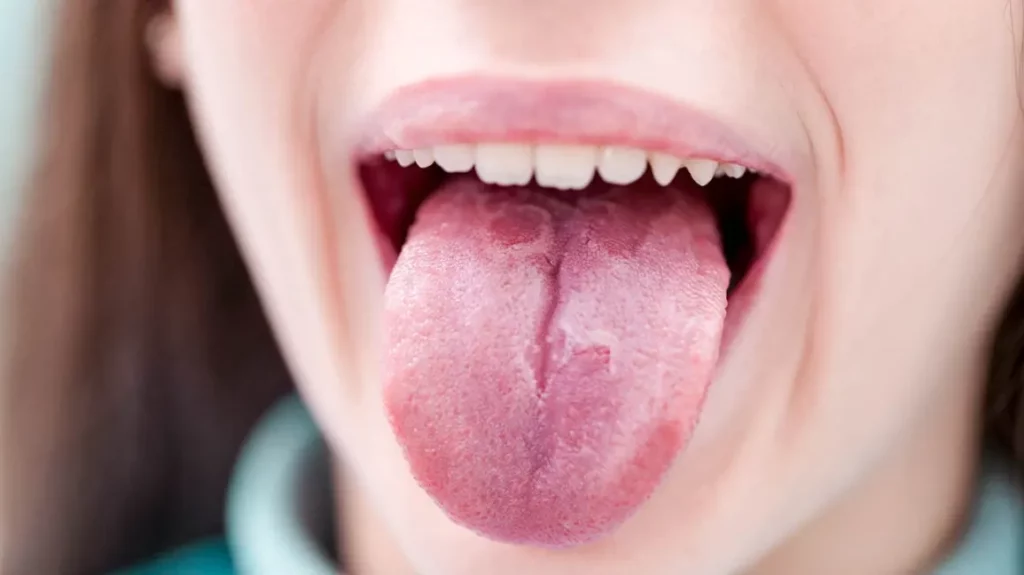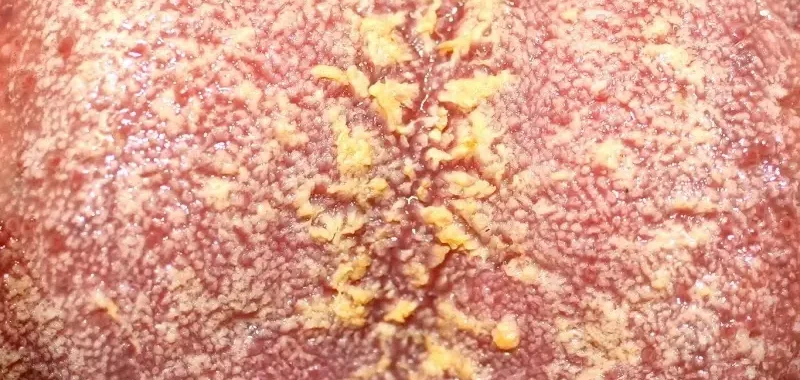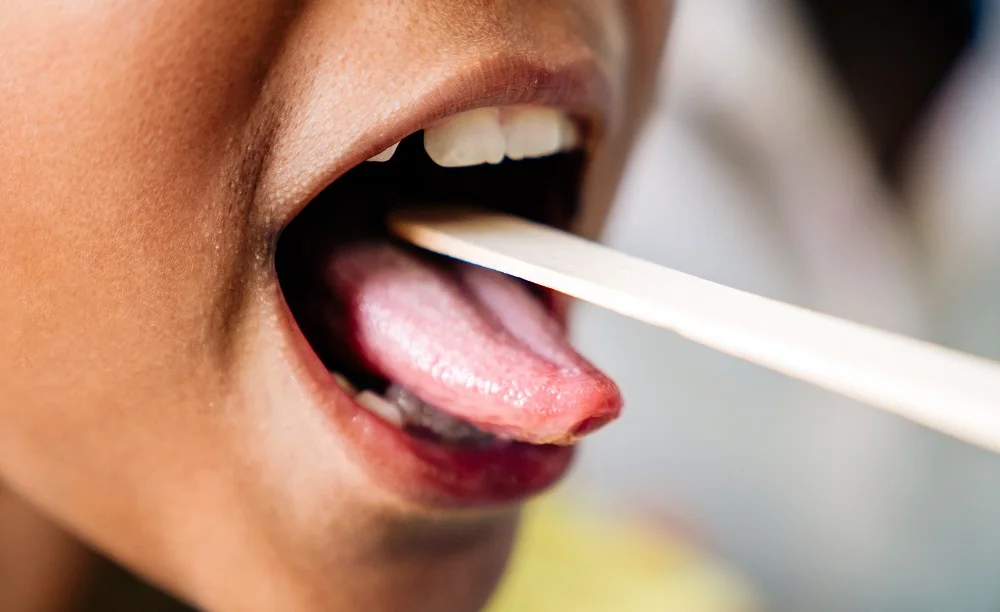Last Updated on: 19th September 2025, 12:52 pm
What is geographic tongue? It is also known as benign migratory glossitis. The term tells you what it consists of, what the symptoms are, and the most predisposed to this oral health condition. Red spots with white edges appear on the tongue, accompanied by pain and discomfort when consuming certain foods or drinks.
What is Geographic Tongue?
This condition is characterized by red spots with white borders that appear on different parts of the tongue. In addition, in the red areas, the papillae that are part of the surface of the tongue are not seen. It can affect the tip, the top, and the sides. Its name, geographic tongue, derives from the map-like shape of these spots.

Although it causes pain and discomfort, it is a harmless condition, is not contagious or infectious, and does not have long-term effects. The geographic tongue tends to run in families and may be hereditary or, or related to one’s genes. It may be the consequence of a vitamin B deficiency, so be sure to take the necessary precautions to keep your tongue healthy. It is important to note that geographic tongue is not related to oral cancer.
Geographic Tongue Symptoms
Some of the afflicted do not perceive symptoms, but the most recognizable signal is the presence of red spots on the tongue.
The symptoms are intermittent; they can appear/disappear and be present for days, weeks, or even years. Some of the signs are:
1. Red spots on the tongue
that resemble an irregularly shaped map and are often surrounded by white or gray borders. The spots appear anywhere on the tongue and can change shape and location.
2. The absence of papillae
inside the red spots. The papillae protect the tongue and help with food intake, making their absence cause discomfort when eating.
3. Burning sensation
Tingling or stinging of the tongue, when eating. This discomfort can come and go, along with the spots. You can find more information as to why your tongue is tingling in this article.
4. Similar spots
It can appear on the top, the gums, or the sides of the tongue, even inside the cheeks. This condition is called geographic stomatitis or erythema migrans.
Who is Prone to Geographic Tongue?
This oral condition is more common in adults, although it can appear at any age. Those who have Reiter syndrome are more predisposed to the geographic tongue. In addition, a relationship has been found between increased stress and this oral health condition.
 It is estimated that about 3% of the population suffers from the geographic tongue, although its prevalence may be even higher. Studies have shown its incidence in children between 4 and 5 years and in adults under 30 years of age. It also occurs more frequently in women than in men.
It is estimated that about 3% of the population suffers from the geographic tongue, although its prevalence may be even higher. Studies have shown its incidence in children between 4 and 5 years and in adults under 30 years of age. It also occurs more frequently in women than in men.
People with the highest predisposition to geographic language are:
1. People with psoriasis, an inflammatory skin condition and predisposing factor.
2. Women who consume oral contraceptives, due to the hormone level increase.
3. Those deficient in zinc, iron, folic acid, and vitamins B6 and B12.
4. People with type 1 diabetes.
5. Those who have a fissured tongue, a condition characterized by wrinkles or deep grooves in the tongue.
6. People with allergic rhinitis, eczema, and other allergies.
Geographic Tongue Home Treatment
To control pain and discomfort, it is recommended to avoid any food or drink that irritates the tongue, such as spicy foods, acidic drinks, hot foods, as well as spices, salt, and some sweets. Plus, avoid excess alcohol consumption. You can find more tips in our separate guide that talks about the treatment for geographic tongue.

Geographic Tongue Side Effects
Although side effects are not common, they usually appear after taking medication for a long time such as headache; stomach ache/heartburn; stomach ulcers, and hypertension. In general, the geographic tongue does not require treatment, but if the situation persists for several days, it is suggested to consult a health professional to rule out other health conditions since a swollen or red tongue may be a sign of other issues.Frequently Asked Questions
What is the cause of geographic tongue?
Geographic tongue is a harmless condition characterised by irregular red patches on the tongue, similar to a map. The exact cause is unknown, but it is thought that irritants such as spicy foods or alcohol can make it worse. Although smoking is detrimental to overall health, it appears to have a protective effect against geographic tongue.
The spots are due to the temporary loss of papillae, the small bumps that give texture to the tongue. In some cases, it can cause burning or sensitivity when eating certain foods. While there is no cure, there are treatments to alleviate the symptoms. Consult a doctor or dentist if you are concerned about geographic tongue.
Can sugar cause geographic tongue?
High blood sugar in patient diabetes may be linked to tongue geográfica, though not definitively proven. Diabetes can cause dry mouth, which might create an environment for the patches of tongue geográfica to develop. People with type 1 diabetes seem to be more prone to it. If you have concerns about geographic tongue, see a doctor or dentist.
What are the symptoms of geographic tongue?
The most prominent symptom of geographic tongue is a distinctive pattern of smooth, red patches on the top and sides of your tongue. These patches are often bordered by a slightly raised, white or yellowish rim. The patches can vary in size and shape, and they may come and go over time.
What should someone look for to identify if they have geographic tongue?
Here’s a checklist to help you identify geographic tongue:
● Red, smooth patches on the top and sides of your tongue.
● White or yellowish borders around the red patches.
● Patches that change size and shape over time.
● No coating on the rest of your tongue.
Is geographic tongue a permanent condition?
No, geographic tongue is not a permanent condition. It’s a benign and temporary inflammatory condition. The patches typically come and go in cycles, lasting for weeks or even months at a time.
Share:
References
1. Actas Dermosifiliográficas (June 2019). Geographic tongue: what should a dermatologist know? / https://www.actasdermo.org/es-lengua-geografica-que-es-lo-articulo-S0001731019300183
2. Bascones-Martínez MA, Valero-Marugán A et al (April 2006) Geographic tongue and atopic dermatitis: a frequent association / https://scielo.isciii.es/scielo.php?script=sci_arttext&pid=S0213-12852006000200002
3. Brigham and Women’s Hospital (nd) Geographic language / https://www.brighamandwomens.org/assets/BWH/surgery/oral-medicine-and-dentistry/pdfs/lengua-geogr%C3%A1fica-spanish-bwh.pdf
4. Mayo Clinic (March 06, 2018.) Geographic Tongue / https://www.mayoclinic.org/diseases-conditions/geographic-tongue/symptoms-causes/syc-20354396
5. Medline Plus (February 1, 2021) Geographic tongue / https://medlineplus.gov/spanish/ency/article/001049.htm
6. Middlesex Health (September 21, 2018) Geographic tongue.
7. Cleveland Clinic (September 23, 2019) Geographic Tongue / https://my.clevelandclinic.org/health/diseases/21177-geographic-tongue
8. Stuart, Annie (April 26, 2022). Geographic Language / https://www.webmd.com/oral-health/guide/geographic-tongue
-
Nayibe Cubillos M. [Author]
Pharmaceutical Chemestry |Pharmaceutical Process Management | Pharmaceutical Care | Pharmaceutical Services Audit | Pharmaceutical Services Process Consulting | Content Project Manager | SEO Knowledge | Content Writer | Leadership | Scrum Master
View all posts
A healthcare writer with a solid background in pharmaceutical chemistry and a thorough understanding of Colombian regulatory processes and comprehensive sector management, she has significant experience coordinating and leading multidisciplina...
















